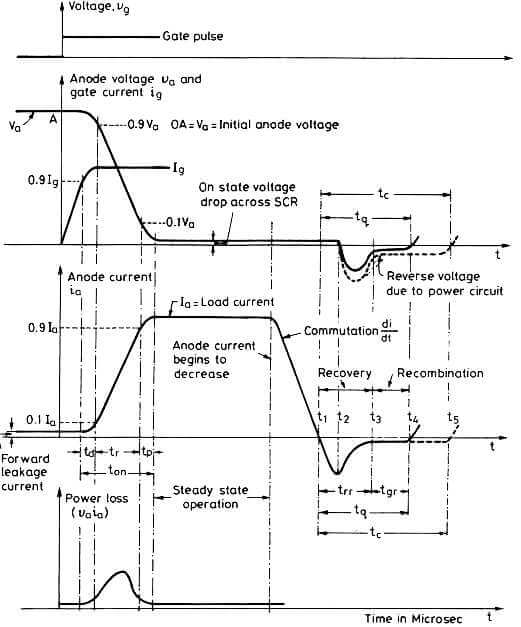SCR Switching Characteristics or Dynamic Characteristics:
- The switching characteristics are important particularly at high-frequency, to define the device velocity in changing from conduction state to blocking state and vice versa.
- Losses occurring in the device during switching from ON state to OFF state and OFF state to ON state is known as Switching Losses.
- The device’s switching characteristics tells us about the switching losses, which is very important parameter to decide the selection of device.
- At high frequency, the switching losses are more.
- This post will discuss about thyristor switching characteristics in detail. It is recommended to read Thyristor-Basics & V-I Characteristics for proper understanding of thyristor switching characteristics.
Turn ON mechanism:-
- When a positive gate signal is applied to a forward biased SCR, the transition of SCR from blocking state to conducting state is called as turn ON mechanism.
- The time taken for SCR to traverse from the blocking state to conducting state is called as turn on time.
- Turn on time is divided into 3 periods.
- tON = td + tr + tp
- td = delay time, tp or ts = peak time (or) spread time
- when the gate current reaches 0.9IG the anode current IA starts increasing and reaches 0.1IA (10% of its max value)
- The time taken for anode current to reach 0.1IA is called as delay time(td).
- In other words, it is the time taken for anode voltage to fall from VA to 0.9VA
- The anode current further increases and reaches 0.9IA.
- The time taken by the anode current to increases from 0.1IA to 0.9IA is called as rise time(tr).
- In other words, it is the time taken by the anode voltage to fall from 0.9VA to 0.1VA
Spread Time or Peak time (ts or tp)
- It is time taken by the anode current to rise from ( 0.9IA to maximum value of IA) 90% to 100% of its full value. (or)
- It is the time taken by VA to fall from 0.1VA to it’s ON state voltage drop(near by zero).
- During this time the conduction spreads over the entire cross-section of cathode and so electrons spread over all the junctions.

Turn OFF mechanism:
- Turning OFF an SCR means bringing the SCR from conducting state to blocking state.
- To turn off an SCR two things are to be done
(1) Reduce the anode current below its holding current level.
(2) Application of reverse voltage. - When the anode current is zero, if we apply forward voltage to the SCR, the device will not be able to block this forward voltage due to the fact that excess charge carriers are still at the junctions, so the device will start conducting even when the gate signal is not applied.
- In order to avoid this, reverse biasing of SCR is done to remove the excess charge carriers from all four layers.
- The turn OFF time is defined as the time from the instant the anode current becomes zero to the instant SCR reaches its forward blocking ability.
Turn off time tOFF = trr + tgr
trr = Reverse recovery time
tgr =Gate recovery time
Reverse recovery process is the removal of excessive charge carries from the top and bottom layers of SCR.
At t1; current IA = 0
- After t1; IA build up in the reverse direction, due to the charge carriers stored in the four layers.
- Reverse recovery current removes the excessive carriers from junctions J1 and J3 during the time t1 to t3. (Reverse recovery current flows due sweeping out of holes from top p-layer and electrons from bottom n layer)
Reverse Recovery Time (trr):-
- It is the time taken for the removal of excessive carriers from top and bottom layer of SCR.
- At t2: When nearly 60% of charges are removed from the outer two layers, the reverse recovery current decreases.
- This decaying causes a reverse voltage to be applied across the SCR.
- At t3 all excessive carriers from J1 and J3 is removed.
- The reverse voltage across SCR removes the excessive carriers from junction J2.
- Gate recovery process is the removal of excessive carriers from J2 junction by application of reverse voltage.
- Time taken for removal of trapped charges from J2 is called gate recovery time(tgr).
- At t4 all the carriers are removed and the device moves to the forward blocking mode.